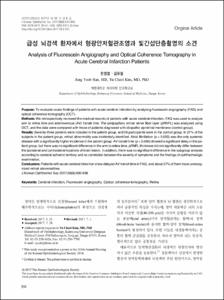급성 뇌경색 환자에서 형광안저혈관조영과 빛간섭단층촬영의 소견
- Keimyung Author(s)
- Kim, Yu Cheol
- Department
- Dept. of Ophthalmology (안과학)
- Journal Title
- Journal of Korean Ophthalmological Society
- Issued Date
- 2017
- Volume
- 58
- Issue
- 8
- Abstract
- Purpose:
To evaluate ocular findings of patients with acute cerebral infarction by analyzing fluorescein angiography (FAG) and optical coherence tomography (OCT).
Methods:
We retrospectively reviewed the medical records of patients with acute cerebral infarction. FAG was used to analyze arm to retina time and arteriovenous (AV) transit time. The peripapillary retinal nerve fiber layer (pRNFL) was analyzed using OCT, and the data were compared with those of patients diagnosed with idiopathic epiretinal membrane (control group).
Results:
Seventy-three patients were included in the patient group, and 56 participants were in the control group. In 27% of the subjects in the patient group, retinal abnormality was incidentally identified. Atrial fibrillation (p < 0.050) was the only systemic disease with a significantly higher incidence in the patient group. AV transit time (p < 0.050) showed a significant delay in the patient group, but there was no significant difference in the arm to retina time. pRNFL thickness did not significantly differ between the ipsilateral and contralateral locations of brain lesion. In addition, there was no significant difference in the subgroup analysis according to cerebral ischemic territory and no correlation between the severity of symptoms and the findings of ophthalmologic examination.
Conclusions:
Patients with acute cerebral infarction show delayed AV transit time in FAG, and about 27% of them have unrecognized retinal abnormalities.
- Alternative Title
- Analysis of Fluorescein Angiography and Optical Coherence Tomography in Acute Cerebral Infarction Patients
- Keimyung Author(s)(Kor)
- 김유철
- Publisher
- School of Medicine (의과대학)
- Citation
- 김유철 and 한정엽. (2017). 급성 뇌경색 환자에서 형광안저혈관조영과 빛간섭단층촬영의 소견. Journal of Korean Ophthalmological Society, 58(8), 930–936. doi: 10.3341/jkos.2017.58.8.930
- Type
- Article
- ISSN
- 0378-6471
- Appears in Collections:
- 1. School of Medicine (의과대학) > Dept. of Ophthalmology (안과학)
- 파일 목록
-
-
Download
 oak-2018-0102.pdf
기타 데이터 / 478.26 kB / Adobe PDF
oak-2018-0102.pdf
기타 데이터 / 478.26 kB / Adobe PDF
-
Items in Repository are protected by copyright, with all rights reserved, unless otherwise indicated.